EDUC 136 Classroom Observation Report: ECE Program, Ages 3-4 Years
VerifiedAdded on 2022/09/11
|7
|1391
|22
Report
AI Summary
This report details an observation of an early childhood education (ECE) program for children aged 3-4, focusing on the teacher's strategies in adapting to student strengths, needs, and cultures. It provides examples of how the teacher individualizes interactions, using different languages and addressing diverse learning needs. The report further examines the teacher's methods for managing learning behaviors through positive guidance and structured activities, such as alphabet lessons and balloon activities, which foster problem-solving, communication, and social skills. The observation also covers the use of play and learning centers to facilitate learning, highlighting the importance of teacher-child interactions. The report concludes with a list of observed learning skills and a discussion of lesson outcomes, emphasizing the significance of a culturally responsive and engaging learning environment.
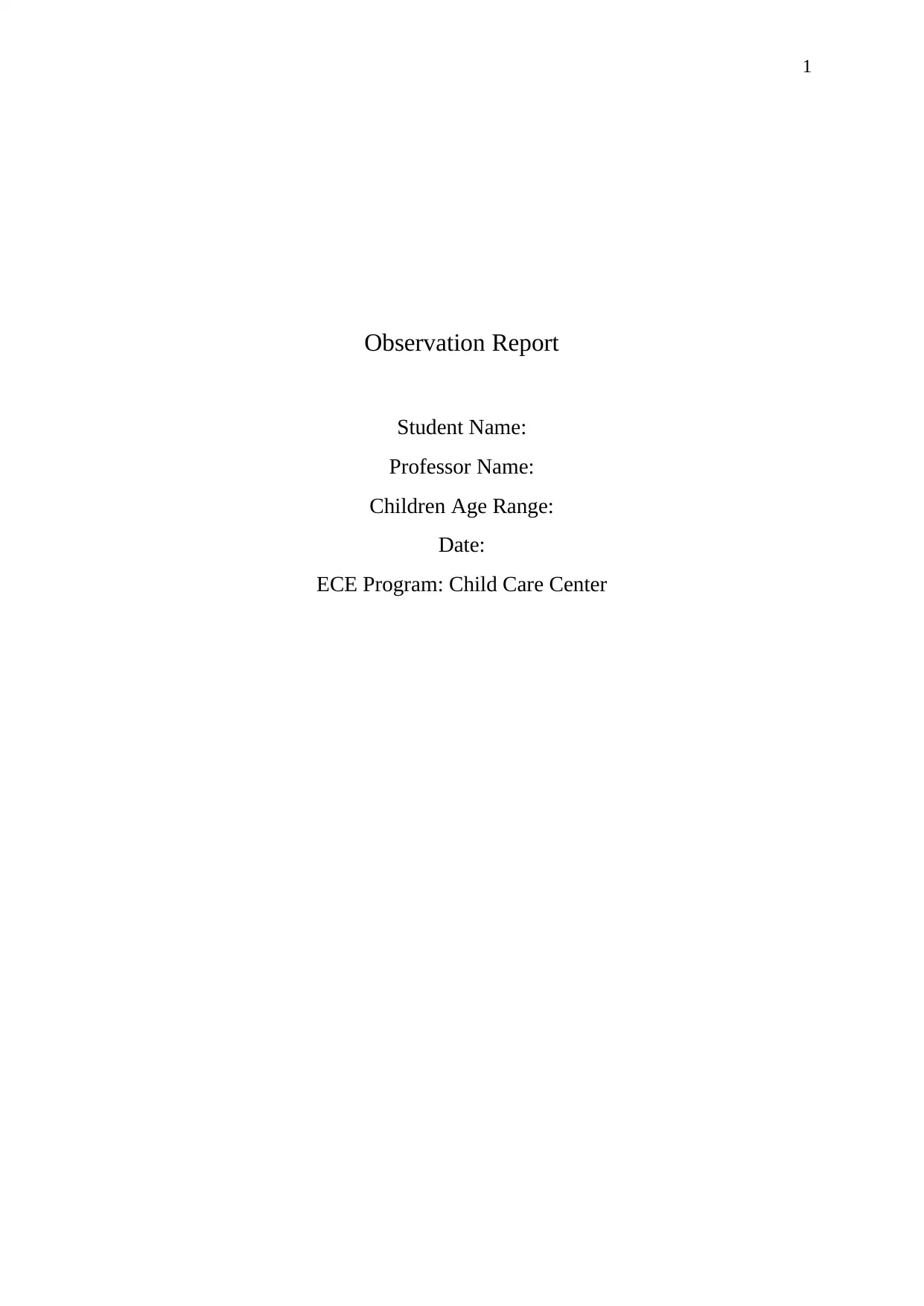
1
Observation Report
Student Name:
Professor Name:
Children Age Range:
Date:
ECE Program: Child Care Center
Observation Report
Student Name:
Professor Name:
Children Age Range:
Date:
ECE Program: Child Care Center
Paraphrase This Document
Need a fresh take? Get an instant paraphrase of this document with our AI Paraphraser
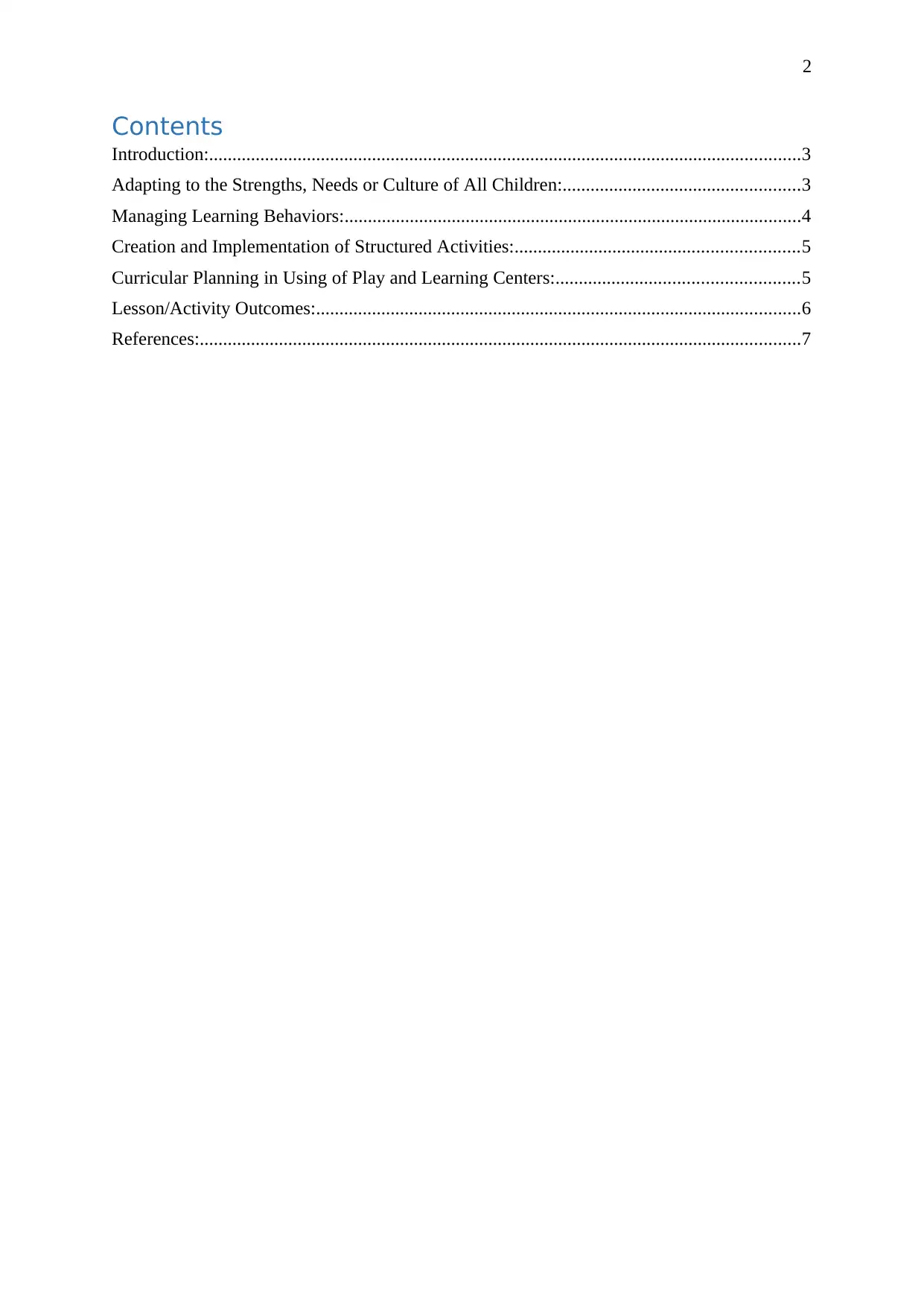
2
Contents
Introduction:...............................................................................................................................3
Adapting to the Strengths, Needs or Culture of All Children:...................................................3
Managing Learning Behaviors:..................................................................................................4
Creation and Implementation of Structured Activities:.............................................................5
Curricular Planning in Using of Play and Learning Centers:....................................................5
Lesson/Activity Outcomes:........................................................................................................6
References:.................................................................................................................................7
Contents
Introduction:...............................................................................................................................3
Adapting to the Strengths, Needs or Culture of All Children:...................................................3
Managing Learning Behaviors:..................................................................................................4
Creation and Implementation of Structured Activities:.............................................................5
Curricular Planning in Using of Play and Learning Centers:....................................................5
Lesson/Activity Outcomes:........................................................................................................6
References:.................................................................................................................................7
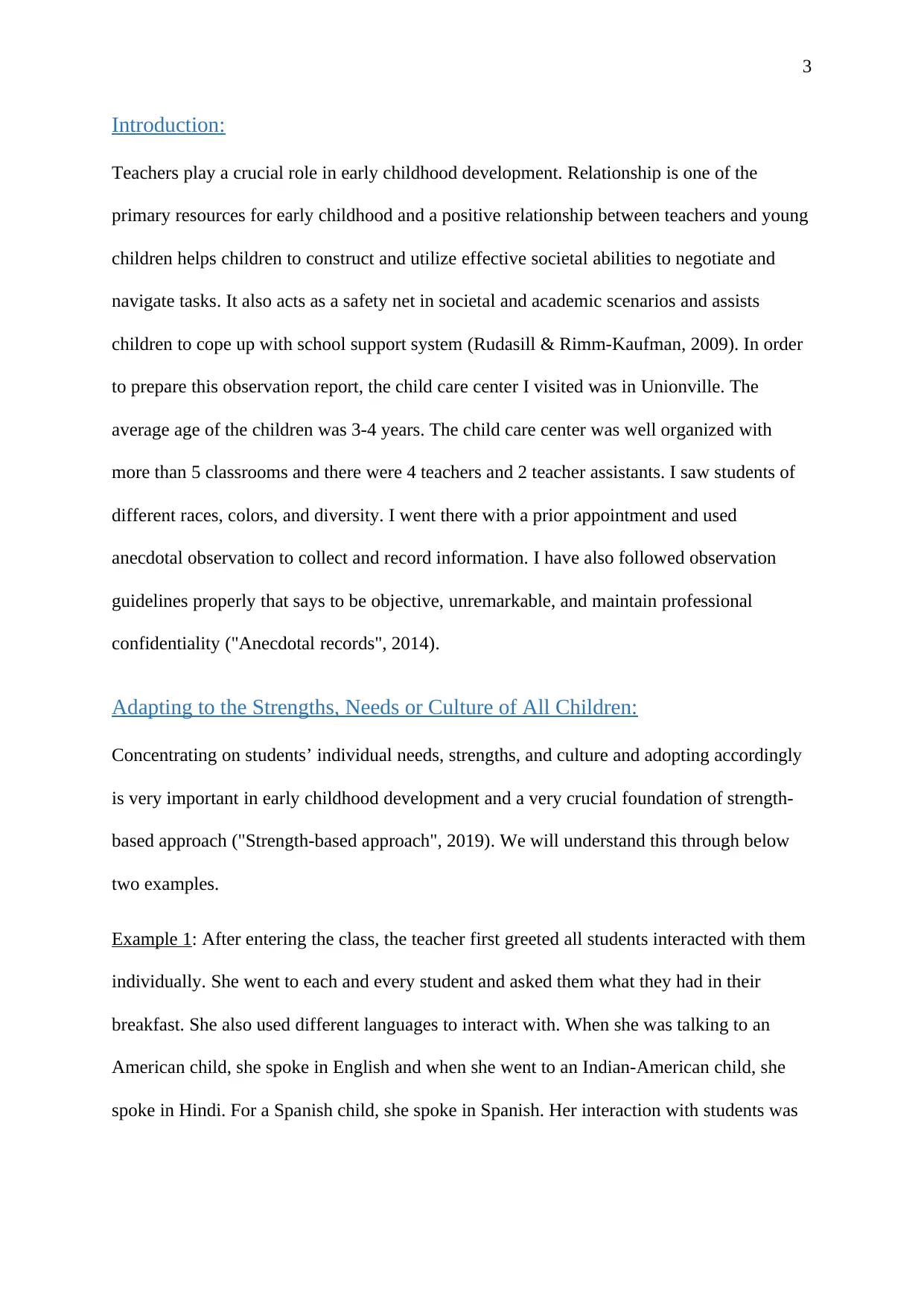
3
Introduction:
Teachers play a crucial role in early childhood development. Relationship is one of the
primary resources for early childhood and a positive relationship between teachers and young
children helps children to construct and utilize effective societal abilities to negotiate and
navigate tasks. It also acts as a safety net in societal and academic scenarios and assists
children to cope up with school support system (Rudasill & Rimm-Kaufman, 2009). In order
to prepare this observation report, the child care center I visited was in Unionville. The
average age of the children was 3-4 years. The child care center was well organized with
more than 5 classrooms and there were 4 teachers and 2 teacher assistants. I saw students of
different races, colors, and diversity. I went there with a prior appointment and used
anecdotal observation to collect and record information. I have also followed observation
guidelines properly that says to be objective, unremarkable, and maintain professional
confidentiality ("Anecdotal records", 2014).
Adapting to the Strengths, Needs or Culture of All Children:
Concentrating on students’ individual needs, strengths, and culture and adopting accordingly
is very important in early childhood development and a very crucial foundation of strength-
based approach ("Strength-based approach", 2019). We will understand this through below
two examples.
Example 1: After entering the class, the teacher first greeted all students interacted with them
individually. She went to each and every student and asked them what they had in their
breakfast. She also used different languages to interact with. When she was talking to an
American child, she spoke in English and when she went to an Indian-American child, she
spoke in Hindi. For a Spanish child, she spoke in Spanish. Her interaction with students was
Introduction:
Teachers play a crucial role in early childhood development. Relationship is one of the
primary resources for early childhood and a positive relationship between teachers and young
children helps children to construct and utilize effective societal abilities to negotiate and
navigate tasks. It also acts as a safety net in societal and academic scenarios and assists
children to cope up with school support system (Rudasill & Rimm-Kaufman, 2009). In order
to prepare this observation report, the child care center I visited was in Unionville. The
average age of the children was 3-4 years. The child care center was well organized with
more than 5 classrooms and there were 4 teachers and 2 teacher assistants. I saw students of
different races, colors, and diversity. I went there with a prior appointment and used
anecdotal observation to collect and record information. I have also followed observation
guidelines properly that says to be objective, unremarkable, and maintain professional
confidentiality ("Anecdotal records", 2014).
Adapting to the Strengths, Needs or Culture of All Children:
Concentrating on students’ individual needs, strengths, and culture and adopting accordingly
is very important in early childhood development and a very crucial foundation of strength-
based approach ("Strength-based approach", 2019). We will understand this through below
two examples.
Example 1: After entering the class, the teacher first greeted all students interacted with them
individually. She went to each and every student and asked them what they had in their
breakfast. She also used different languages to interact with. When she was talking to an
American child, she spoke in English and when she went to an Indian-American child, she
spoke in Hindi. For a Spanish child, she spoke in Spanish. Her interaction with students was
⊘ This is a preview!⊘
Do you want full access?
Subscribe today to unlock all pages.

Trusted by 1+ million students worldwide
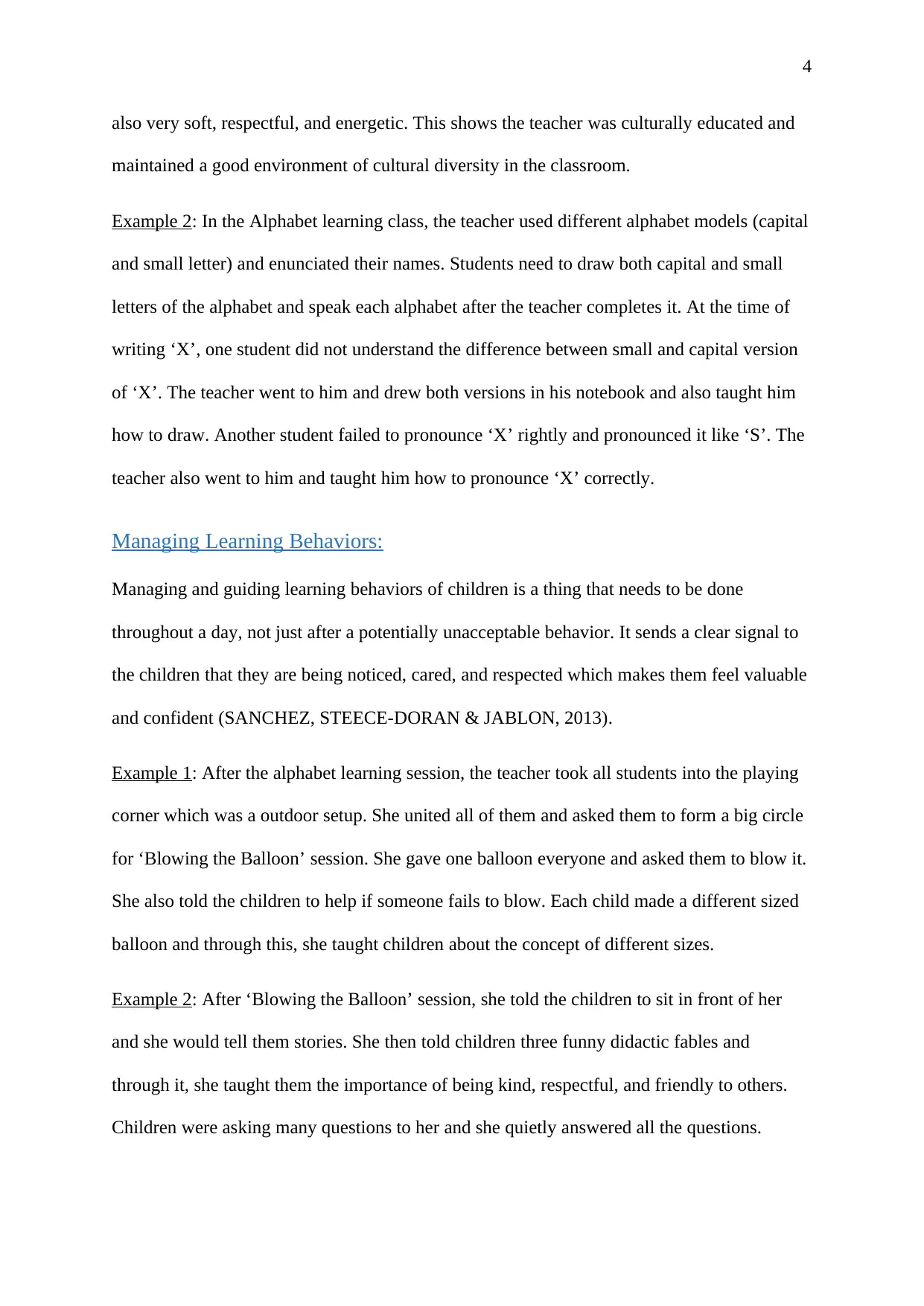
4
also very soft, respectful, and energetic. This shows the teacher was culturally educated and
maintained a good environment of cultural diversity in the classroom.
Example 2: In the Alphabet learning class, the teacher used different alphabet models (capital
and small letter) and enunciated their names. Students need to draw both capital and small
letters of the alphabet and speak each alphabet after the teacher completes it. At the time of
writing ‘X’, one student did not understand the difference between small and capital version
of ‘X’. The teacher went to him and drew both versions in his notebook and also taught him
how to draw. Another student failed to pronounce ‘X’ rightly and pronounced it like ‘S’. The
teacher also went to him and taught him how to pronounce ‘X’ correctly.
Managing Learning Behaviors:
Managing and guiding learning behaviors of children is a thing that needs to be done
throughout a day, not just after a potentially unacceptable behavior. It sends a clear signal to
the children that they are being noticed, cared, and respected which makes them feel valuable
and confident (SANCHEZ, STEECE-DORAN & JABLON, 2013).
Example 1: After the alphabet learning session, the teacher took all students into the playing
corner which was a outdoor setup. She united all of them and asked them to form a big circle
for ‘Blowing the Balloon’ session. She gave one balloon everyone and asked them to blow it.
She also told the children to help if someone fails to blow. Each child made a different sized
balloon and through this, she taught children about the concept of different sizes.
Example 2: After ‘Blowing the Balloon’ session, she told the children to sit in front of her
and she would tell them stories. She then told children three funny didactic fables and
through it, she taught them the importance of being kind, respectful, and friendly to others.
Children were asking many questions to her and she quietly answered all the questions.
also very soft, respectful, and energetic. This shows the teacher was culturally educated and
maintained a good environment of cultural diversity in the classroom.
Example 2: In the Alphabet learning class, the teacher used different alphabet models (capital
and small letter) and enunciated their names. Students need to draw both capital and small
letters of the alphabet and speak each alphabet after the teacher completes it. At the time of
writing ‘X’, one student did not understand the difference between small and capital version
of ‘X’. The teacher went to him and drew both versions in his notebook and also taught him
how to draw. Another student failed to pronounce ‘X’ rightly and pronounced it like ‘S’. The
teacher also went to him and taught him how to pronounce ‘X’ correctly.
Managing Learning Behaviors:
Managing and guiding learning behaviors of children is a thing that needs to be done
throughout a day, not just after a potentially unacceptable behavior. It sends a clear signal to
the children that they are being noticed, cared, and respected which makes them feel valuable
and confident (SANCHEZ, STEECE-DORAN & JABLON, 2013).
Example 1: After the alphabet learning session, the teacher took all students into the playing
corner which was a outdoor setup. She united all of them and asked them to form a big circle
for ‘Blowing the Balloon’ session. She gave one balloon everyone and asked them to blow it.
She also told the children to help if someone fails to blow. Each child made a different sized
balloon and through this, she taught children about the concept of different sizes.
Example 2: After ‘Blowing the Balloon’ session, she told the children to sit in front of her
and she would tell them stories. She then told children three funny didactic fables and
through it, she taught them the importance of being kind, respectful, and friendly to others.
Children were asking many questions to her and she quietly answered all the questions.
Paraphrase This Document
Need a fresh take? Get an instant paraphrase of this document with our AI Paraphraser
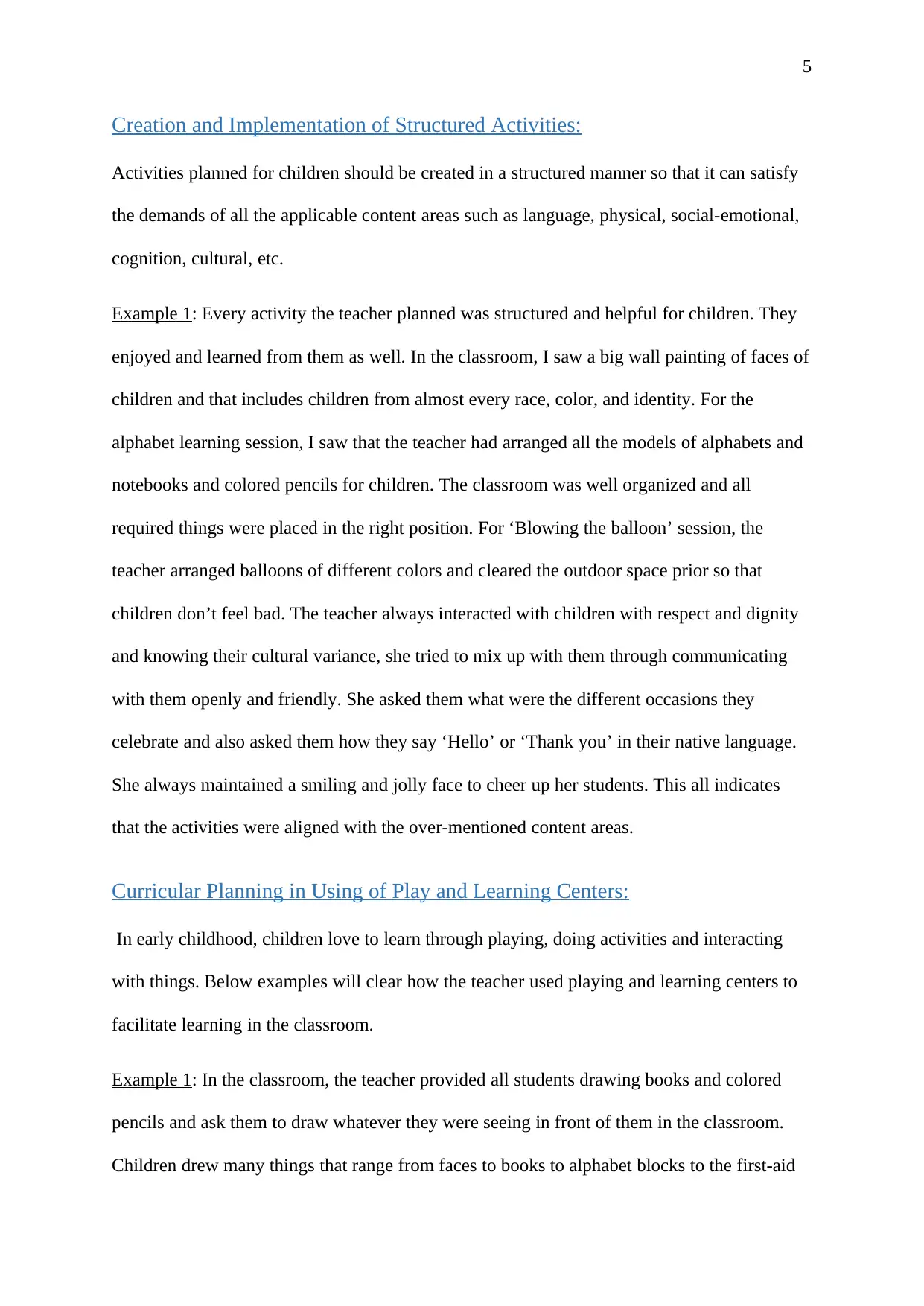
5
Creation and Implementation of Structured Activities:
Activities planned for children should be created in a structured manner so that it can satisfy
the demands of all the applicable content areas such as language, physical, social-emotional,
cognition, cultural, etc.
Example 1: Every activity the teacher planned was structured and helpful for children. They
enjoyed and learned from them as well. In the classroom, I saw a big wall painting of faces of
children and that includes children from almost every race, color, and identity. For the
alphabet learning session, I saw that the teacher had arranged all the models of alphabets and
notebooks and colored pencils for children. The classroom was well organized and all
required things were placed in the right position. For ‘Blowing the balloon’ session, the
teacher arranged balloons of different colors and cleared the outdoor space prior so that
children don’t feel bad. The teacher always interacted with children with respect and dignity
and knowing their cultural variance, she tried to mix up with them through communicating
with them openly and friendly. She asked them what were the different occasions they
celebrate and also asked them how they say ‘Hello’ or ‘Thank you’ in their native language.
She always maintained a smiling and jolly face to cheer up her students. This all indicates
that the activities were aligned with the over-mentioned content areas.
Curricular Planning in Using of Play and Learning Centers:
In early childhood, children love to learn through playing, doing activities and interacting
with things. Below examples will clear how the teacher used playing and learning centers to
facilitate learning in the classroom.
Example 1: In the classroom, the teacher provided all students drawing books and colored
pencils and ask them to draw whatever they were seeing in front of them in the classroom.
Children drew many things that range from faces to books to alphabet blocks to the first-aid
Creation and Implementation of Structured Activities:
Activities planned for children should be created in a structured manner so that it can satisfy
the demands of all the applicable content areas such as language, physical, social-emotional,
cognition, cultural, etc.
Example 1: Every activity the teacher planned was structured and helpful for children. They
enjoyed and learned from them as well. In the classroom, I saw a big wall painting of faces of
children and that includes children from almost every race, color, and identity. For the
alphabet learning session, I saw that the teacher had arranged all the models of alphabets and
notebooks and colored pencils for children. The classroom was well organized and all
required things were placed in the right position. For ‘Blowing the balloon’ session, the
teacher arranged balloons of different colors and cleared the outdoor space prior so that
children don’t feel bad. The teacher always interacted with children with respect and dignity
and knowing their cultural variance, she tried to mix up with them through communicating
with them openly and friendly. She asked them what were the different occasions they
celebrate and also asked them how they say ‘Hello’ or ‘Thank you’ in their native language.
She always maintained a smiling and jolly face to cheer up her students. This all indicates
that the activities were aligned with the over-mentioned content areas.
Curricular Planning in Using of Play and Learning Centers:
In early childhood, children love to learn through playing, doing activities and interacting
with things. Below examples will clear how the teacher used playing and learning centers to
facilitate learning in the classroom.
Example 1: In the classroom, the teacher provided all students drawing books and colored
pencils and ask them to draw whatever they were seeing in front of them in the classroom.
Children drew many things that range from faces to books to alphabet blocks to the first-aid
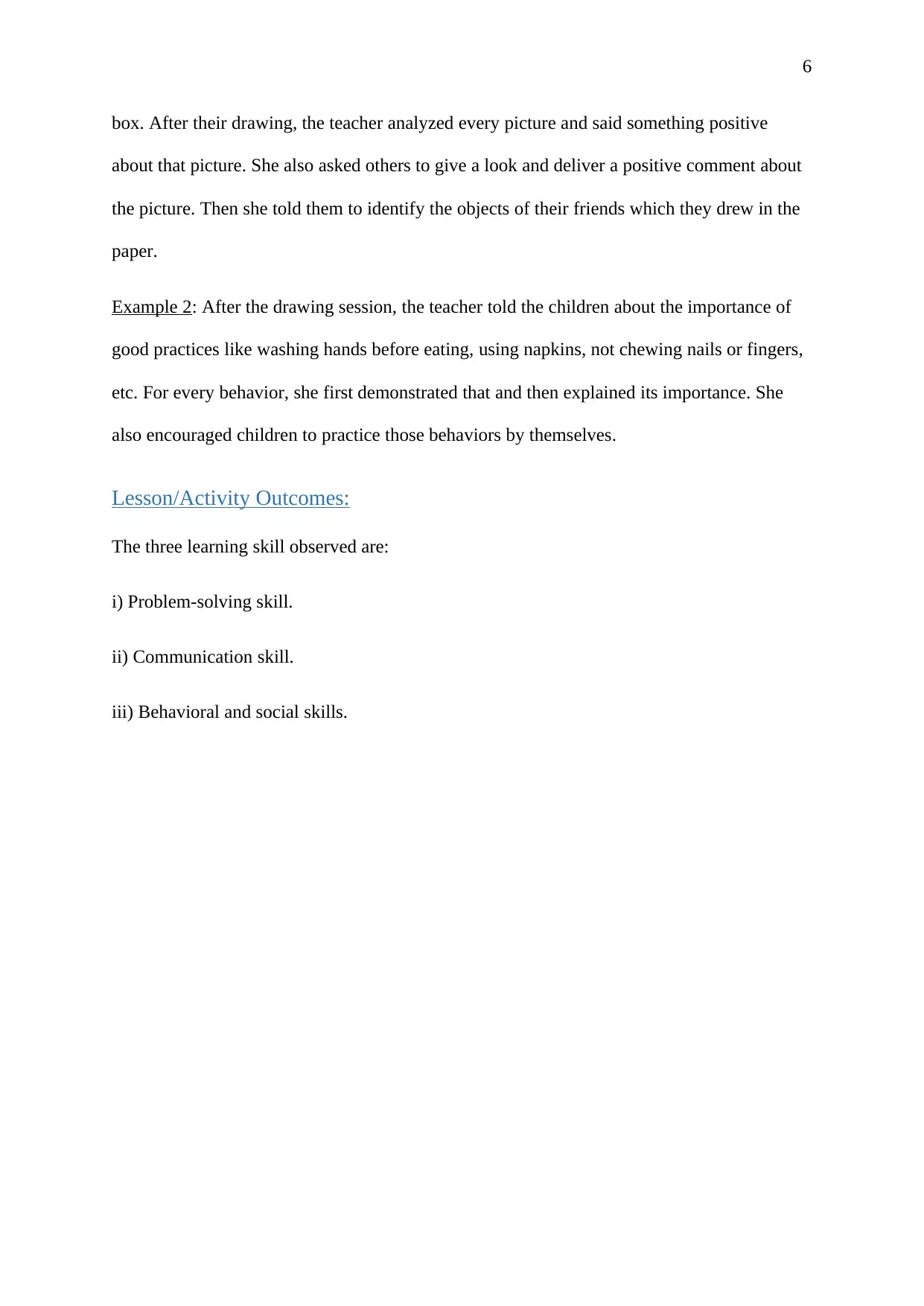
6
box. After their drawing, the teacher analyzed every picture and said something positive
about that picture. She also asked others to give a look and deliver a positive comment about
the picture. Then she told them to identify the objects of their friends which they drew in the
paper.
Example 2: After the drawing session, the teacher told the children about the importance of
good practices like washing hands before eating, using napkins, not chewing nails or fingers,
etc. For every behavior, she first demonstrated that and then explained its importance. She
also encouraged children to practice those behaviors by themselves.
Lesson/Activity Outcomes:
The three learning skill observed are:
i) Problem-solving skill.
ii) Communication skill.
iii) Behavioral and social skills.
box. After their drawing, the teacher analyzed every picture and said something positive
about that picture. She also asked others to give a look and deliver a positive comment about
the picture. Then she told them to identify the objects of their friends which they drew in the
paper.
Example 2: After the drawing session, the teacher told the children about the importance of
good practices like washing hands before eating, using napkins, not chewing nails or fingers,
etc. For every behavior, she first demonstrated that and then explained its importance. She
also encouraged children to practice those behaviors by themselves.
Lesson/Activity Outcomes:
The three learning skill observed are:
i) Problem-solving skill.
ii) Communication skill.
iii) Behavioral and social skills.
⊘ This is a preview!⊘
Do you want full access?
Subscribe today to unlock all pages.

Trusted by 1+ million students worldwide
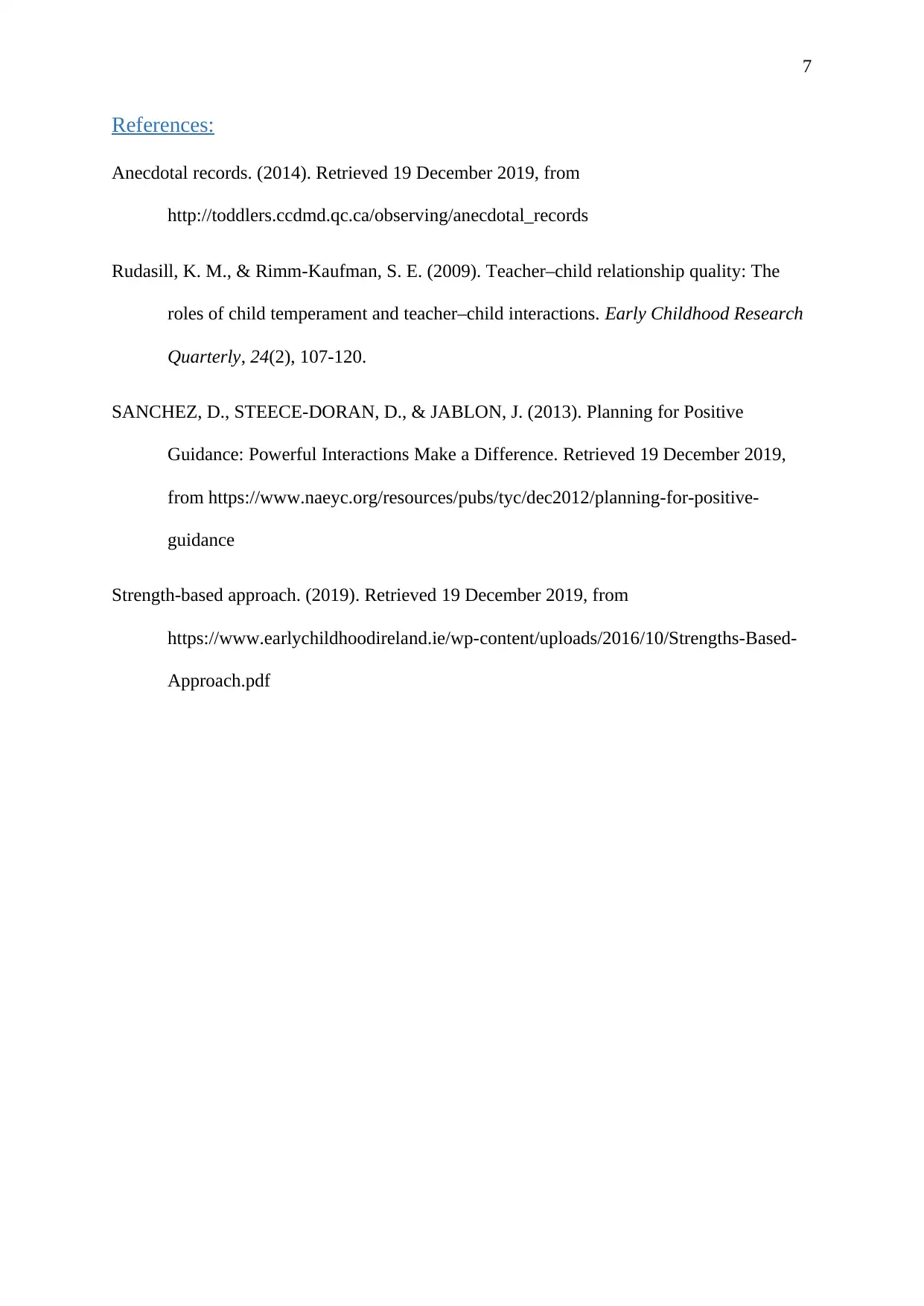
7
References:
Anecdotal records. (2014). Retrieved 19 December 2019, from
http://toddlers.ccdmd.qc.ca/observing/anecdotal_records
Rudasill, K. M., & Rimm-Kaufman, S. E. (2009). Teacher–child relationship quality: The
roles of child temperament and teacher–child interactions. Early Childhood Research
Quarterly, 24(2), 107-120.
SANCHEZ, D., STEECE-DORAN, D., & JABLON, J. (2013). Planning for Positive
Guidance: Powerful Interactions Make a Difference. Retrieved 19 December 2019,
from https://www.naeyc.org/resources/pubs/tyc/dec2012/planning-for-positive-
guidance
Strength-based approach. (2019). Retrieved 19 December 2019, from
https://www.earlychildhoodireland.ie/wp-content/uploads/2016/10/Strengths-Based-
Approach.pdf
References:
Anecdotal records. (2014). Retrieved 19 December 2019, from
http://toddlers.ccdmd.qc.ca/observing/anecdotal_records
Rudasill, K. M., & Rimm-Kaufman, S. E. (2009). Teacher–child relationship quality: The
roles of child temperament and teacher–child interactions. Early Childhood Research
Quarterly, 24(2), 107-120.
SANCHEZ, D., STEECE-DORAN, D., & JABLON, J. (2013). Planning for Positive
Guidance: Powerful Interactions Make a Difference. Retrieved 19 December 2019,
from https://www.naeyc.org/resources/pubs/tyc/dec2012/planning-for-positive-
guidance
Strength-based approach. (2019). Retrieved 19 December 2019, from
https://www.earlychildhoodireland.ie/wp-content/uploads/2016/10/Strengths-Based-
Approach.pdf
1 out of 7
Related Documents
Your All-in-One AI-Powered Toolkit for Academic Success.
+13062052269
info@desklib.com
Available 24*7 on WhatsApp / Email
![[object Object]](/_next/static/media/star-bottom.7253800d.svg)
Unlock your academic potential
Copyright © 2020–2025 A2Z Services. All Rights Reserved. Developed and managed by ZUCOL.




